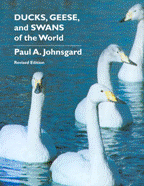Papers in the Biological Sciences
Date of this Version
2010
Document Type
Book Chapter
Abstract
Mute Swan
Black Swan
Black-necked Swan
Trumpeter Swan
Whooper Swan
Whistling Swan
Bewick Swan
Coscoroba Swan
Swan Goose
Bean Goose
White-fronted Goose
Lesser White-fronted Goose
Graylag Goose
Bar-headed Goose
Snow Goose
Ross Goose
Emperor Goose
Hawaiian Goose
Canada Goose
Barnacle Goose
Brant
Red-breasted Goose
The swans and true geese are moderately to extremely large waterfowl, which in common with the whistling ducks have plumage patterns that are alike in both sexes and lack iridescent coloration, and they also possess reticulated scale patterns on the tarsal surfaces. Most of the 20 species are found in the cooler parts of the Northern Hemisphere, the exceptions being 3 species of Southern Hemisphere swans. All are vegetarians, obtaining much of their food from terrestrial surface vegetation in the case of geese, and from subsurface aquatic vegetation in the case of swans. The patterns of the downy young tend to be pale and simple, without strong head or back patterning, and in most species the adult plumages are also fairly simple, with whites and blacks often predominating. The white plumage of most adult swans appears to be related to visibility needs associated with their high degree of territorial spacing. The most highly territorial swans are also the most strongly vocal ones, for the same reason. However, vocalizations of the sexes are very similar, and usually differ only in minor pitch characteristics. Most of the swans and geese are quite strongly migratory, but the insular Hawaiian goose not only has become nonmigratory but also has become semiterrestrial and has evolved reduced toe webbing as it has adapted to a mountainous existence on old lava fields.


Comments
In Ducks, Geese, and Swans of the World, by Paul A. Johnsgard. Electronic edition copyright © 2010 Paul A. Johnsgard.